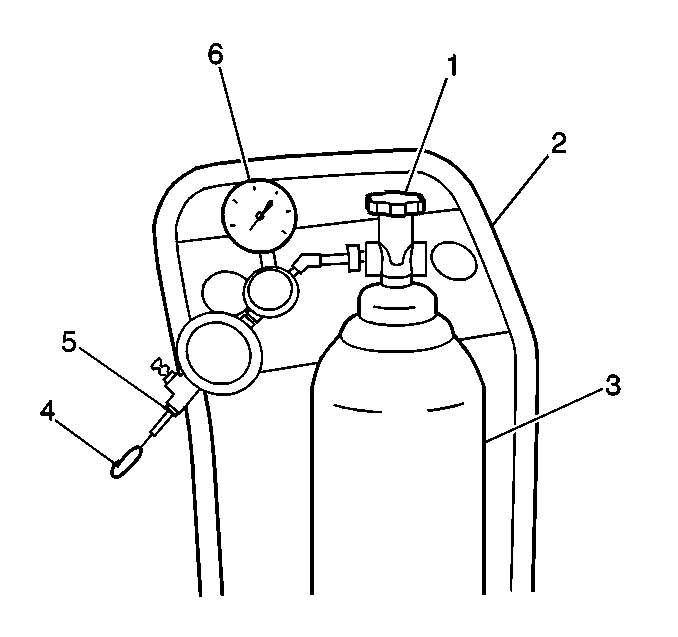Fuel Supply Components Oldsmobile Only
Caution: This vehicle is equipped with Supplemental Inflatable Restraint (SIR). Refer to the Cautions in the On-Vehicle Service and the SIR Component and Wiring Location view in the Supplemental Inflatable (SIR) System before any performing service on or around SIR components or wiring. Failure to follow the Cautions could result in possible air bag deployment, personal injury, or otherwise unneeded SIR system repairs.
Notice: Always use the correct fastener in the proper location. When you replace a fastener, use ONLY the exact part number for that application.
The applicable service procedure will identify, where necessary, those fasteners that must be replaced after removal; or those fasteners that require the use of thread locking compound or thread sealant. UNLESS OTHERWISE SPECIFIED, do not use supplemental coatings (paints, greases, or other corrosion inhibitors) on threaded fasteners or fastener joint interfaces. Generally, such coatings adversely affect the fastener torque and the joint clamping force, and may damage the fastener. When you install fasteners, use the correct tightening sequence and specifications. Following these instructions can help you avoid damage to parts and systems.The fuel supply is stored in the fuel tank. An electric fuel pump, inside the modular fuel sender assembly (inside the fuel tank) pumps fuel through an in-pipe filter to the fuel injection system. The fuel pump is designed to provide fuel at a pressure above the regulated pressure needed by the fuel injectors. A fuel pressure regulator keeps fuel available to the fuel injectors at a regulated pressure. Unused fuel is returned to the fuel tank by a separate pipe.
Unleaded fuel must be used with all gasoline engines for proper emission control system operation. Using unleaded fuel will also decrease spark plug fouling and extend engine oil life. Leaded fuel can damage the emission control system, and its use can result in loss of emission warranty coverage.
All vehicles with gasoline engines are equipped with an evaporative emission system that minimizes the escape of fuel vapors to the atmosphere.
Fuel Tank
The fuel tank is used to store fuel for the vehicle. The tank is located in the rear of the vehicle and is held in place by two metal straps that are attached to the underbody. The fuel tank is made of steel and is coated internally with a special corrosion inhibitor. Due to the internal coating of the fuel tank, the fuel tank is not repairable. The fuel tank shape includes a reservoir in order to maintain a constant supply of fuel around the fuel pump strainer during low fuel conditions and aggressive vehicle maneuvers. A fuel tank filler pipe check-ball tube is welded to the fuel tank and extends from the fuel tank inlet to the reservoir. The fuel tank filler pipe check-ball is located inside the fuel tank filler pipe check-ball tube and prevents fuel from splashing back out of the fuel tank filler pipe during refueling.
Fuel Tank Filler Pipe Cap
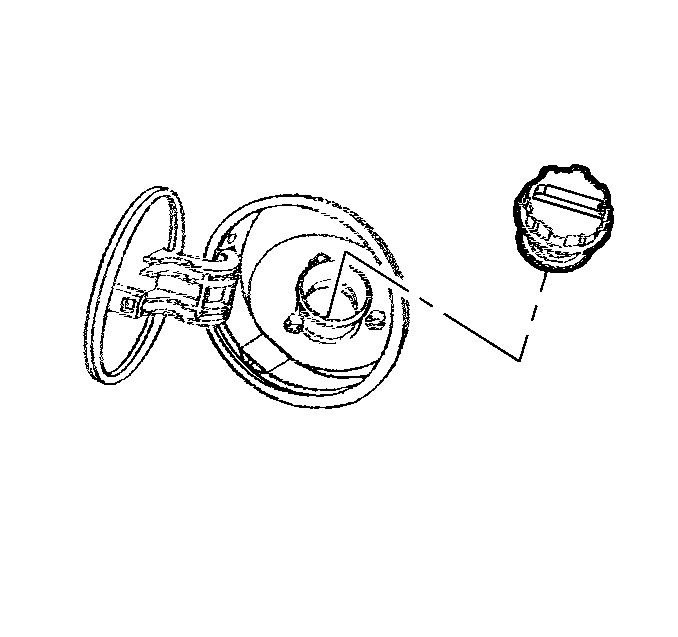
Notice: Use a fuel tank filler pipe cap with the same features as the original when a replacement is necessary. Failure to use the correct fuel tank filler pipe cap can result in a serious malfunction of the fuel system.
In order to prevent refueling with leaded fuel, the fuel tank filler pipe has a built-in restrictor and deflector.
The fuel tank filler pipe is equipped with a threaded-type fuel tank filler pipe cap. The threaded part of the fuel tank filler pipe cap requires several turns counterclockwise before it can be removed. A built-in torque-limiting device prevents over tightening of the fuel tank filler pipe cap. In order to install the fuel tank filler pipe cap, turn the fuel tank filler pipe cap clockwise until at least 3 clicking noises are heard. The clicking noises signal that the correct torque has been reached and that the fuel tank filler pipe cap is fully seated.
Fuel Sender Assembly
The fuel sender assembly is attached to the top of the fuel tank, and extends from the top of the fuel tank to the reservoir.
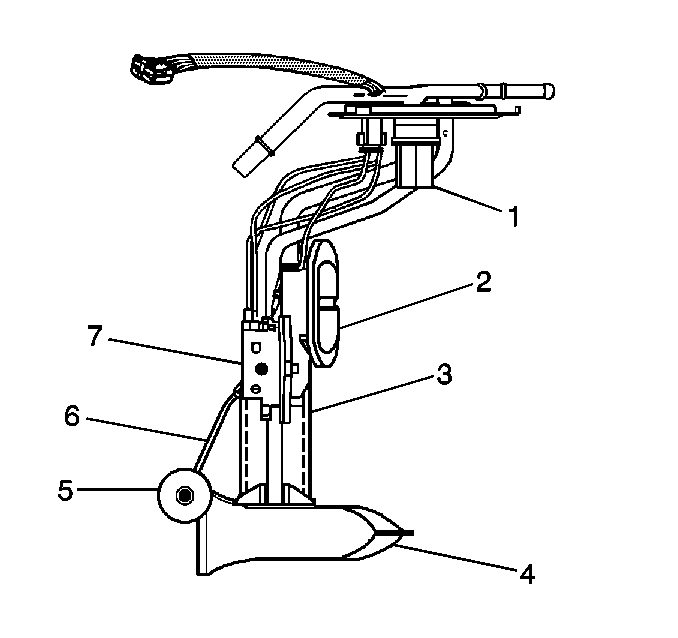
The fuel sender assembly consists of the following major components: a fuel sender (7), a fuel pump (3), a fuel pump strainer (4), a fuel pulse dampener (2), and a roll-over valve (1).
The fuel sender consists of the float (5), the wire float arm (6), the rheostat and the roll-over valve. The fuel level is sensed by the position of the float and float arm, which operate the 90 ohms rheostat. As the float position changes, the amount of current passing through the rheostat varies, thus changing the Gauge reading on the instrument panel.
The roll-over valve is pressed into the EVAP pipe of the fuel sender and is not serviced separately. The roll-over valve prevents fuel from entering the engine compartment if the vehicle rolls over by shutting OFF the EVAP pipe to the evaporative emission canister.
Fuel Pump

A high pressure roller vane fuel pump (3) is mounted to the fuel sender (7) inside the fuel tank. The fuel is pumped to the engine at a specified flow and pressure through the fuel pump. Excess fuel is returned to the fuel tank by a return pipe. The fuel pump delivers a constant flow of fuel to the engine even during low fuel conditions and aggressive vehicle maneuvers.
The electric fuel pump operation is controlled by the Powertrain Control Module (PCM) through a fuel pump relay. Refer to Fuel Pump Electrical Circuit Diagnosis .
Fuel Pump Strainer

A woven plastic fuel pump strainer (4) is attached to the lower end of the fuel pump (3) in the fuel tank. The functions of the fuel pump strainer are to filter contaminants and to wick fuel.
The life of the fuel pump strainer is generally considered to be that of the fuel pump. The fuel pump strainer is self-cleaning and normally requires no maintenance. Fuel stoppage at this point indicates that the fuel tank contains an abnormal amount of sediment or water, in which case the tank should be thoroughly cleaned. Refer to Fuel System Cleaning . If the fuel pump strainer is plugged, replace it with a new one.
Fuel Pulse Dampener

The fuel pulse dampener (2) is installed between the fuel pump and the fuel sender in order to dampen fuel pulsation and reduce noise generated by the fuel pump.
In-Pipe Fuel Filter
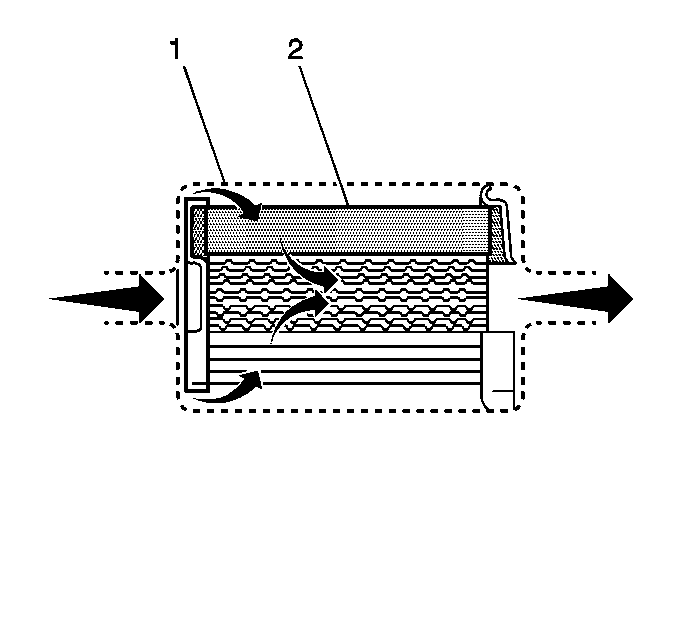
A fuel filter is used in the fuel feed pipe ahead of the fuel injection system. The fuel filter is mounted directly in front of the fuel tank. The fuel filter housing (1) is constructed of steel with a quick-connect fitting at the inlet of the fuel filter and a threaded fitting at the outlet of the fuel filter. The threaded fitting is sealed with an O-ring, which is replaceable. The filter element (2) is made of paper and is designed to trap particles suspended in the fuel that may damage the injection system.
There is no service interval for in-pipe fuel filter replacement. Only replace the in-pipe fuel filter if it is restricted.
Fuel Feed and Fuel Return Pipes
The fuel feed and fuel return pipes carry fuel from the fuel sender assembly to the fuel injection system and back to the fuel sender assembly.
Nylon Fuel Pipes
Caution: In order to Reduce the Risk of Fire and Personal Injury:
• If nylon fuel pipes are nicked, scratched or damaged during installation,
Do Not attempt to repair the sections of the nylon fuel pipes. Replace them. • When installing new fuel pipes, Do Not hammer directly on the
fuel harness body clips as it may damage the nylon pipes resulting in a possible
fuel leak. • Always cover nylon vapor pipes with a wet towel before using a
torch near them. Also, never expose the vehicle to temperatures higher than
115°C (239°F) for more than one hour, or more than 90°C (194°F)
for any extended period. • Before connecting fuel pipe fittings, always apply a few drops
of clean engine oil to the male pipe ends. This will ensure proper reconnection
and prevent a possible fuel leak. (During normal operation, the O-rings located
in the female connector will swell and may prevent proper reconnection if
not lubricated.)
Nylon fuel pipes are designed to perform the same job as the steel or flexible fuel pipes or hoses they replace. Nylon fuel pipes are constructed to withstand maximum fuel system pressure, exposure to fuel additives, and changes in temperature. There are two sizes used: 3/8" ID for the fuel feed pipe, and 5/16" ID for the fuel return pipe.
The fuel feed and fuel return pipes are assembled as a harness. Retaining clips hold the fuel pipes together and provide a means for attaching the fuel pipes to the vehicle. Sections of the fuel pipes that are exposed to chafing, high temperature or vibration are protected with heat resistant rubber hose and/or corrugated plastic conduit.
Nylon fuel pipes are somewhat flexible and can be formed around gradual turns under the vehicle. However, if forced into sharp bends, nylon fuel pipes will kink and restrict fuel flow. Also, once exposed to fuel, nylon fuel pipes may become stiffer and are more likely to kink if bent too far. Special care should be taken when working on a vehicle with nylon fuel pipes.
Quick Connect Fittings
Quick-connect type fittings provide a simplified means of installing and connecting fuel system components. Depending on the vehicle model, there are two types of quick-connect fittings, each used at different locations in the fuel system. Each type of quick-connect fitting consists of a unique female connector and a compatible male fuel pipe end. O-rings, located inside the female connector, provide the fuel seal. Integral locking tabs or fingers hold the quick-connect fittings together.
Engine Fuel Pipe O-Rings
The fuel feed and fuel return pipe connections at the fuel metering system are sealed with replaceable O-ring seals. These O-ring seals are made of special material, and should only be serviced with the correct service part.
EVAP Pipes
The EVAP pipes are made of nylon and carry vapors from the fuel sender assembly and the evaporative emission canister purge valve to the evaporative emission canister.
Fuel Supply Components Chevrolet Only
Fuel Tank
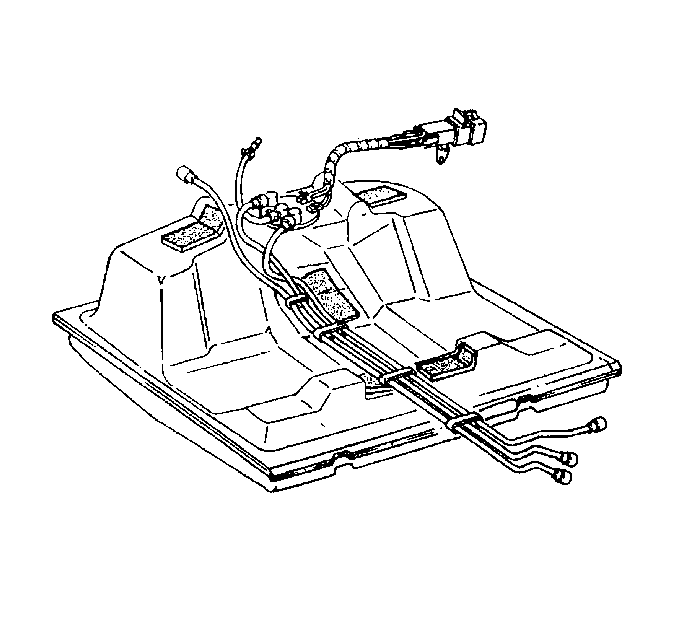
The fuel tank is used to store fuel for the vehicle. The tank is located in the rear of the vehicle and is held in place by two metal straps that are attached to the underbody. The fuel tank is made of steel and is coated internally with a special corrosion inhibitor. Due to the internal coating of the fuel tank, the fuel tank is not repairable.The fuel tank shape includes a reservoir in order to maintain a constant supply of fuel around the fuel pump strainer during low fuel conditions and aggressive vehicle maneuvers. A fuel tank filler pipe check-valve tube is attached to the fuel tank and extends from the fuel tank inlet to the reservoir. The fuel tank filler pipe check-valve is located inside the fuel tank filler pipe check-valve tube and prevents fuel from splashing back out of the fuel tank filler pipe during refueling.
Fuel Tank Filler Pipe
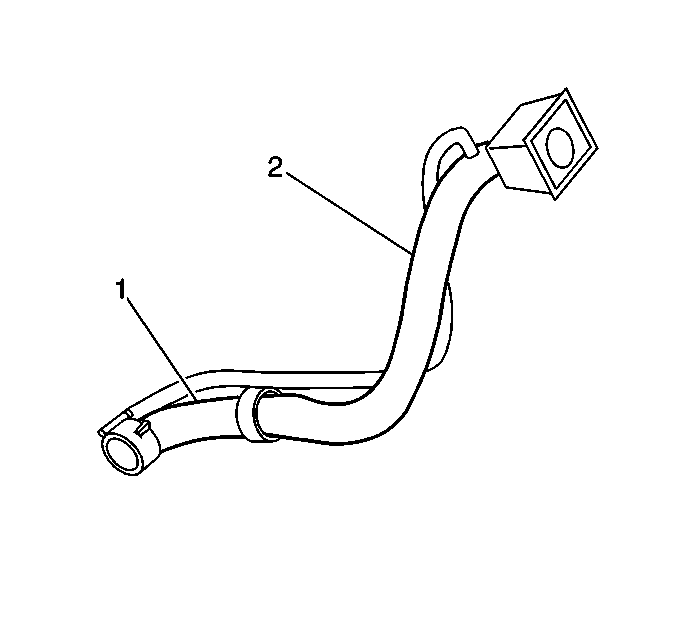
In order to prevent refueling with leaded fuel, the fuel tank filler pipe (2) has a built-in restrictor and deflector. The fuel tank filler pipe is connected to the fuel tank filler extension (1) by clamps.
Fuel Tank Filler Pipe Cap
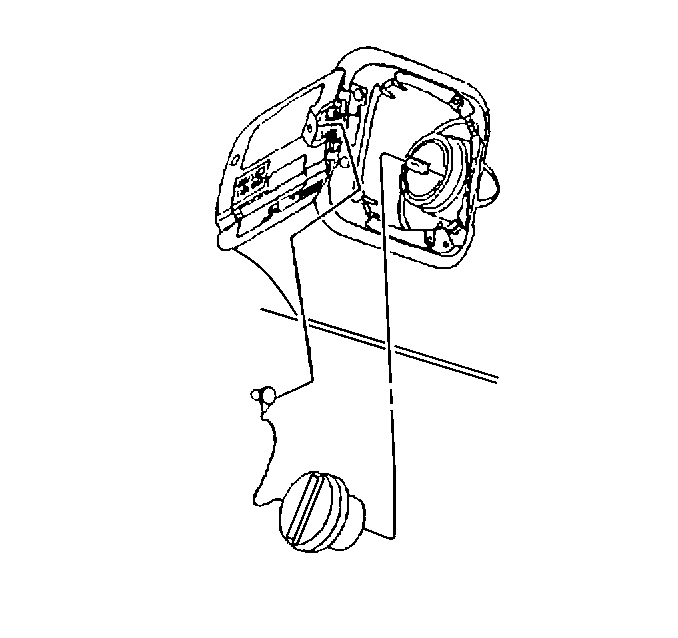
The fuel tank filler pipe is equipped with a threaded-type fuel tank filler pipe cap. The threaded part of the fuel tank filler pipe cap requires several turns counterclockwise before it can be removed. A built-in torque-limiting device prevents over tightening of the fuel tank filler pipe cap. In order to install the fuel tank filler pipe cap, turn the fuel tank filler pipe cap clockwise until at least 3 clicking noises are heard. The clicking noises signal that the correct torque has been reached and that the fuel tank filler pipe cap is fully seated. The Enhanced EVAP fuel tank pipe cap has a tether connected to the fuel filler door.
Notice: Use a fuel tank filler pipe cap with the same features as the original when a replacement is necessary. Failure to use the correct fuel tank filler pipe cap can result in a serious malfunction of the fuel system.
Fuel Tank Pressure Sensor
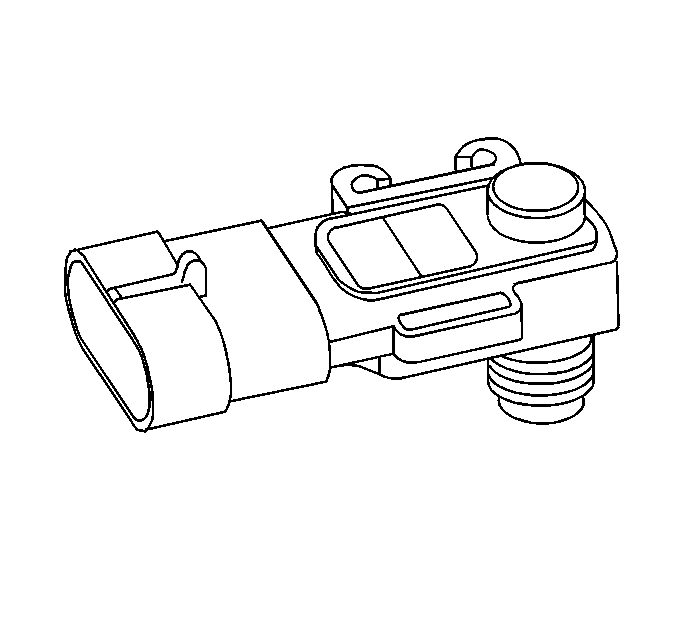
The fuel tank pressure sensor is a three wire strain gauge sensor much like that of the common GM MAP sensor. However, this sensor has very different electrical characteristics due to its pressure differential design. The sensor measures the difference between the air pressure (or vacuum) in the fuel tank and the outside air pressure. The sensor mounts at the top of the fuel tank. A three wire electrical harness connects it to the Powertrain Control Module (PCM). The PCM supplies a five volt reference voltage and ground to the sensor. The sensor will return a voltage between 0.1 and 4.9 volts. When the air pressure in the fuel tank is equal to the outside air pressure, such as when the fuel fill cap is removed, the output voltage of the sensor will be 1.3 to 1.7 volts.
Fuel Sender Assembly
The modular fuel sender assembly is attached to the top of the fuel tank, and extends from the top of the fuel tank to the reservoir.
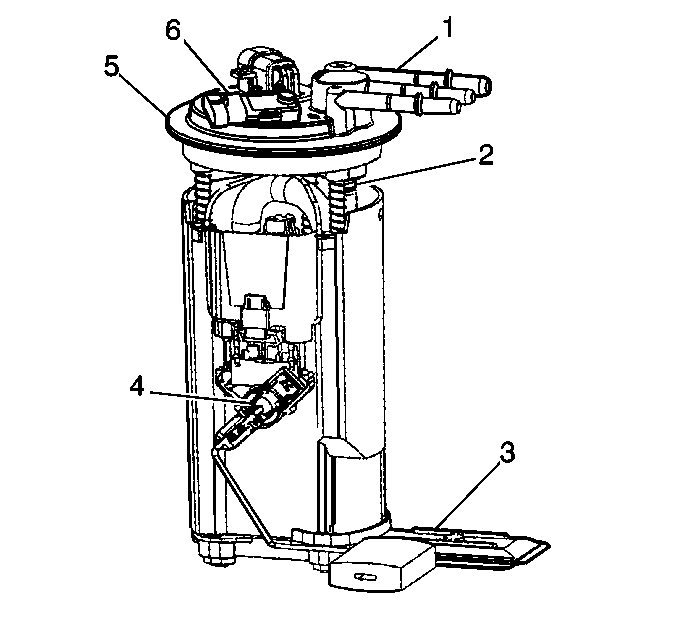
The modular fuel sender assembly consists of the following major components: a fuel pump, a fuel sender strainer (3), a fuel pump strainer, a roll-over valve (2), a fuel level sensor (4), and, a fuel tank pressure sensor (6).
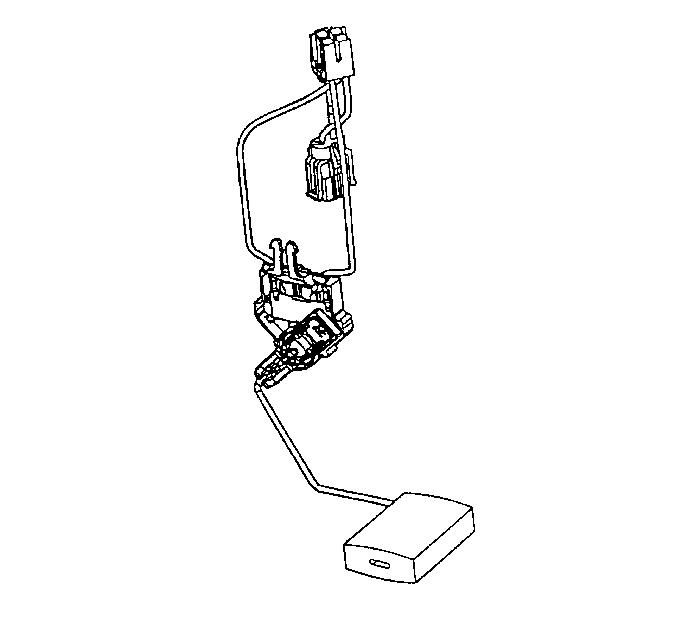
The fuel sender consists of the float, the wire float arm, and the rheostat. The rheostat is mounted on the fuel sender and located in series with the voltage supply circuit from the fuel gage or body control module (BCM). As the position of the float varies with the fuel level, the rheostat produces a variable resistance between the fuel gage or BCM and ground. The fuel gage converts this variable resistance into the fuel level reading display on the instrument panel.
The roll-over valve is pressed into the EVAP pipe of the fuel sender and is not serviced separately. The roll-over valve prevents fuel from entering the EVAP canister if the vehicle rolls over by shutting OFF the EVAP pipe to the evaporative emission canister.
Fuel Pump
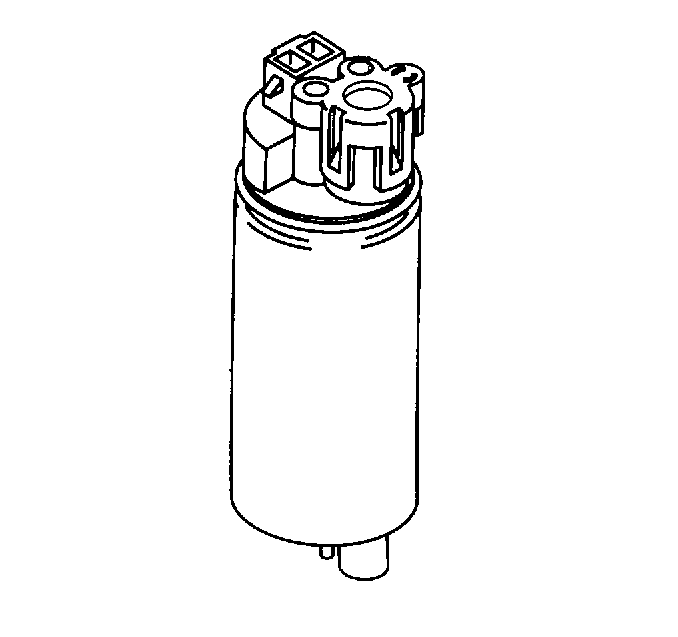
A high pressure gerotor fuel pump is mounted to the fuel sender inside the fuel tank. The fuel is pumped to the engine at a specified flow and pressure through the fuel pump. Excess fuel is returned to the fuel tank by a return pipe. The fuel pump delivers a constant flow of fuel to the engine even during low fuel conditions and aggressive vehicle maneuvers.
The electric fuel pump operation is controlled by the Powertrain Control Module (PCM) through a fuel pump relay. Refer to Fuel Pump Electrical Circuit Diagnosis
Fuel Pump Strainer

A woven plastic fuel pump strainer is attached to the lower end of the fuel pump in the fuel tank. The functions of the fuel pump strainer are to filter contaminants and to wick fuel.
The life of the fuel pump strainer is generally considered to be that of the fuel pump. The fuel pump strainer is self-cleaning and normally requires no maintenance. Fuel stoppage at this point indicates that the fuel tank contains an abnormal amount of sediment or water, in which case the tank should be thoroughly cleaned. Refer to Fuel System Cleaning
In-Pipe Fuel Filter

A fuel filter is used in the fuel feed pipe ahead of the fuel injection system. The fuel filter is mounted directly in front of the fuel tank. The fuel filter housing (1) is constructed of steel with a quick-connect fitting at the inlet of the fuel filter and a threaded fitting at the outlet of the fuel filter. The threaded fitting is sealed with an O-ring, which is replaceable. The filter element (2) is made of paper and is designed to trap particles suspended in the fuel that may damage the injection system.
There is no service interval for in-pipe fuel filter replacement. Only replace the in-pipe fuel filter if it is restricted.
Fuel Feed and Fuel Return Pipes
The fuel feed and fuel return pipes carry fuel from the fuel sender assembly to the fuel injection system and back to the fuel sender assembly.
Nylon Fuel Pipes
Caution: In order to Reduce the Risk of Fire and Personal Injury:
• If nylon fuel pipes are nicked, scratched or damaged during installation,
Do Not attempt to repair the sections of the nylon fuel pipes. Replace them. • When installing new fuel pipes, Do Not hammer directly on the
fuel harness body clips as it may damage the nylon pipes resulting in a possible
fuel leak. • Always cover nylon vapor pipes with a wet towel before using a
torch near them. Also, never expose the vehicle to temperatures higher than
115°C (239°F) for more than one hour, or more than 90°C (194°F)
for any extended period. • Before connecting fuel pipe fittings, always apply a few drops
of clean engine oil to the male pipe ends. This will ensure proper reconnection
and prevent a possible fuel leak. (During normal operation, the O-rings located
in the female connector will swell and may prevent proper reconnection if
not lubricated.)
Nylon fuel pipes are designed to perform the same job as the steel or rubber fuel lines they replace. Nylon pipes are constructed to withstand maximum fuel system pressure, exposure to fuel additives and changes in temperature. There are two sizes used: 3/8" ID for the fuel feed, and 5/16" ID for the fuel return and are used on the modular sender. Nylon fuel pipes are somewhat flexible and can be formed around gradual turns. However, if forced into sharp bends, nylon pipes will kink and restrict fuel flow. Also, once exposed to fuel, nylon pipes may become stiffer and are more likely to kink if bent too far. Special care should be taken when working on a vehicle with nylon pipes.
Quick Connect Fittings
Quick-connect type fittings provide a simplified means of installing and connecting fuel system components. Depending on the vehicle model, there are two types of quick-connect fittings, each used at different locations in the fuel system. Each type of quick-connect fitting consists of a unique female connector and a compatible male fuel pipe end. O-rings, located inside the female connector, provide the fuel seal. Integral locking tabs or fingers hold the quick-connect fittings together.
Fuel Pipe O-Rings
Fuel feed and return pipe threaded connections at the fuel rail and fuel filter are sealed with replaceable O-ring seals. These O-rings seals are made of special material, and should only be serviced with the correct service part.
Enhanced Evaporative Emission (EVAP) Service Port
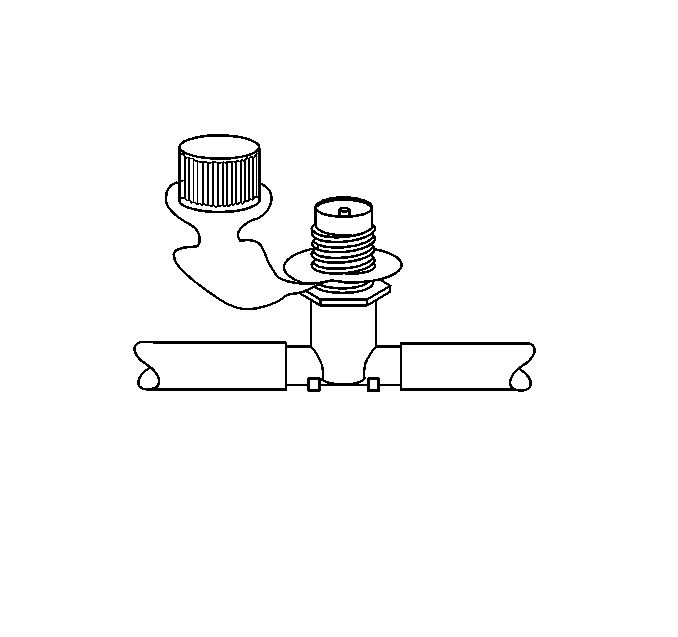
The enhanced EVAP service port is located in the evaporative purge hose
located in the evaporative purge hose located between the purge solenoid and
the canister. The service port is identified by a green colored cap. The port
contains a schrader valve and fittings to allow connections of
